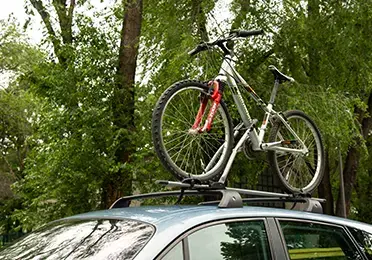There are various types of bike racks, and their installation methods depend on the model of the car you drive.
Roof mounted bike racks
Roof-Mounted Bike racks are the safest but potentially most expensive option for transporting bikes. However, your decision to purchase a roof rack also depends on your car model and its height. For standard cars or smaller crossovers, a roof rack is an excellent choice. However, for SUVs or jeeps, the roof rack may not be practical due to the height of these vehicles, which makes placing the bike on the rack challenging. What you should also have in mind is that most roof mounted bike racks allow the transportation of 2 bikes maximum.

Trunk mounted bike racks
This type of bike rack is compatible with almost every car model’s trunk. Its simple design includes a metal frame and adjustable straps with metal hooks at the ends. These hooks attach to the openings around the trunk, making installation easy. Despite its adaptability, this type of bike rack is the most suitable for sedans, coupes, and convertibles. However, for wagons, hatchbacks, crossovers, and SUVs, it may not be the ideal option. The trunk mounted bike rack is more stable on inclined surfaces than flat ones.
Hitch mounted bike racks
There are two types of hitch-mounted bike racks: the “S” shape and the “T” shape. The second type functions as a platform where bikes are placed with a vertical bar stabilizing the upper part of the bikes. The hitch mounted bike rack is suitable for all car models equipped with a tow hitch. It’s also a cost-effective option for cars that allow straightforward installation of a tow hitch. This type of rack allows you to move the bikes away from the trunk, allowing access to the boot.
Driving tips with a bike rack
Always remember that regardless of the rack type, your car is carrying additional weight, so adjust your driving speed accordingly. When using a roof mounted bike rack, be aware that your car’s height increases. Before parking in a garage, remove the bikes from the rack. Also, check the compatibility of your bike with the specific rack type you’re interested in. Some racks have a primary attachment point for the bike frame, while others use a wheel arm or front fork as the primary attachment point.

How to choose the right bike rack?

5 useful tips for safe towing

10 suggestions for protecting your car from summer heat

